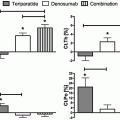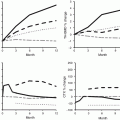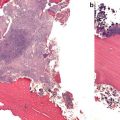How to classify a patient suspected for ONJ
Criteria by AAOMS
1. Present and/or previous bisphosphonate or other antiresorptive treatment
Yes
2. Previous radiation to the jaws
No
3. Exposed bone for ≥8 weeks
Yes
4. Staging as follows
Stage 0
Patients with no clinical evidence of necrotic bone, but present with nonspecific symptoms or clinical and radiographic findings
Symptoms
• Odontalgia not explained by an odontogenic cause
• Dull, aching bone pain in the body of the mandible, which may radiate to the temporomandibular joint region
• Sinus pain, which may be associated with inflammation and thickening of the maxillary sinus wall
• Altered neurosensory function
Clinical findings
• Loosening of teeth not explained by chronic periodontal disease
• Periapical/periodontal fistula that is not associated with pulpal necrosis due to caries
Radiographic findings
• Alveolar bone loss or resorption not attributable to chronic periodontal disease
• Changes to trabecular pattern—dense woven bone and persistence of unremodeled bone in extraction sockets
• Thickening/obscuring of periodontal ligament (thickening of the lamina dura and decreased size of the periodontal ligament space)
• Inferior alveolar canal narrowing
These nonspecific findings, which characterize stage 0, may occur in patients with a prior history of stage 1, 2, or 3 disease who have healed and have no clinical evidence of exposed bone
Stage 1
Exposed bone
No symptoms
Stage 2
Exposed bone
Symptoms of infection
Stage 3
Exposed and necrotic bone in patients with pain, infection, and one or more of the following:
• Exposed necrotic bone extending beyond the region of alveolar bone, that is, inferior border and ramus in the mandible, maxillary sinus, and zygoma in the maxilla
• Pathologic fracture
• Extraoral fistula
• Oral–antral/oral–nasal communication
• Osteolysis extending to the inferior border of the mandible or sinus floor
However, the subgroup of nonexposed ONJ (with no fistula) is still not covered by the consensus classification. The nonexposed ONJ has been described in a number of studies [16–18]. The proportion of nonexposed ONJ ranges from 14 to 35 % of an ONJ population [16, 18, 19]. If nonexposed ONJs are not recognized or accepted, it might have a significant consequence for epidemiologic studies potentially leading to underreporting [18]. One should bear in mind that odontologic infectious foci as, for example, a dental periapical infection or sinusitis from a periapical infection close to the sinus, should be excluded as the cause of symptoms before a diagnosis of nonexposed ONJ is made.
Schiodt et al. [18] published suggested criteria for nonexposed ONJ (Table 13.2). Nonexposed ONJ has an overlap with stage 0 (Ruggerio et al. 2009 [10]), and it is suggested to avoid using stage 0 and instead use nonexposed ONJ (Table 13.2), and those from the previous stage 0 who do not fulfill criteria for nonexposed ONJ can be classified as “at risk.” Examples of “at risk” patients are patients on BP treatment with radiologically widened lamina dura around the teeth but without symptoms from the jaw.
Table 13.2
Criteria for classification of exposed and nonexposed osteonecrosis after Schiodt et al. (2014) [18]
How to classify a patient suspected for ONJ | Criteria by Schiodt et al. (2014) [18] | |
|---|---|---|
Criteria for exposed ONJ (E-ONJ) | Criteria for nonexposed ONJ (NE-ONJ) | |
1. Present and/or previous bisphosphonate or other antiresorptive treatment | Yes | Yes |
2. Previous radiation to the jaws | No | No |
3. Exposed bone for ≥8 weeks | Yes | No Accepted as ONJ if 1. Intraoral or extraoral fistula and/or 2. Jaw pain 3. Swelling 4. Sequestrum formation on imaging 5. Necrotic bone on histopathology. If specimen available. Item 5 is mandatory |
4. Staging as follows | ||
Stage 0 | NA | NA |
Stage 1 | Exposed bone No symptoms Name: E-ONJ, stage 1 | Not exposed bone No symptoms Name: NE-ONJ, stage 1 |
Stage 2 | Exposed bone Symptoms of infection Name: E-ONJ, stage 2 | Not exposed bone Symptoms of infections Name: NE-ONJ, stage 2 |
Stage 3 | As AAOMS stage 3 Name: E-ONJ, stage 3 | Nonexposed and necrotic bone in patients with pain, infection, and one or more of the following • Nonexposed necrotic bone demonstrated on imaging extending beyond the region of alveolar bone, that is, inferior border and ramus in the mandible, maxillary sinus, and zygoma in the maxilla • Pathologic fracture • Extraoral fistula • Oral–antral/oral–nasal communication • Osteolysis extending to the inferior border of the mandible or sinus floor Name: NE-ONJ, stage 3 |
Epidemiology
Since the first description by Marx et al. in 2003 [1], increasing numbers of ONJ have been reported. The literature reports quite varying incidence rates from less than 0.01 to 18.6 % [20–22]. Generally, ONJ occurs more frequently among patients on intravenous treatment with nitrogen-containing bisphosphonates, compared to peroral tablet treatment. The incidence is much higher among cancer patients with skeletal metastases or multiple myeloma compared with that seen in osteoporosis patients. The varying incidence rate may be influenced by study designs, as some studies are retrospective or based on questionnaires without an oral examination possibly underestimating the incidence, and others are based on a detailed oral examination by dental or maxillofacial specialists. Prospective studies of the latter type reveal incidences of more than 10 % [20, 23, 24]. For example, Walter et al. [20] reported an incidence of 18.6 % in zoledronate-treated cancer patients in a prospective design with thorough dental examination of all patients. In contrast, patients with osteoporosis have a much lower risk, around 0.1 % [25].
In a recent large multi-clinic case–control study from Australia involving 4212 patients recruited during a 6-month window period, Borromeo et al. [26] found that odds ratio for osteoporosis patients on bisphosphonate treatment developing delayed healing (including ONJ) was 11.6 (95 % CI 1.9–69.4; P = 0.01).
A systematic literature review by Solomon et al. [27] included nine studies and patient populations exceeding 500,000 bisphosphonate-treated patients. They reported an incidence rate for ONJ among osteoporosis patients varying from 0.028 to 4.3 %. The relative risk for ONJ among bisphosphonate-treated osteoporosis patients showed odds ratio of 7.2–9.2 [27]. Another systematic review among osteoporosis patients from 2013 revealed comparable results [28].
A case–control study of ONJ cases diagnosed after January 1st 2003 in the USA involving several NIH-supported private dental practice research networks identified 191 cases of ONJ and allocated 573 controls [29]. Patients with a history of any cancer had odds ratio of 14.3 for ONJ compared with those without cancer. Similarly, patients with osteoporosis (OR = 7.0), diabetes (OR = 1.7), or anemia (OR = 3.1) had higher associations with ONJ compared with individuals without these conditions. Excluding those with cancer, bisphosphonate use of varying length and local risk factors as oral suppuration and dental extraction were highly associated with ONJ [29]. Table 13.3 gives an overview of the findings of Barasch et al. [29], including the odds ratio for ONJ with varying length of oral bisphosphonate treatment.
Table 13.3
Risk factors for osteonecrosis of the jaws among study participants without cancer in case–control study
Risk factor | ONJ cases (n = 30) | Controls (N = 81) | Odds ratio (95 % CI) | P-value |
|---|---|---|---|---|
Oral suppuration | Yes | No | 11.9 (2.0–69.5) | 0.006 |
Tooth extraction | Matched extraction | Any extraction | 6.6 (1.6–26.6) | 0.008 |
Oral bisphosphonate | Yes | No | 7.2 (2.1–24.7) | 0.002 |
Bisphosphonate use any type | <0–2 years | 9.9 (2.2–45.6) | 0.003 | |
2–5 years | 39.8 (10.0–158.8) | <0.0001 | ||
>5 years | 38.6 (9.1–163.6) | <0.0001 |
Risk Factors
Risk factors for the occurrence of ONJ may be systemic or local, which may be present both in patients treated for malignant bone involvement or benign conditions including osteoporosis. In the following, the emphasis will be on data from osteoporosis.
Stay updated, free articles. Join our Telegram channel

Full access? Get Clinical Tree







